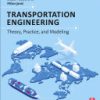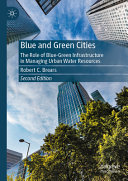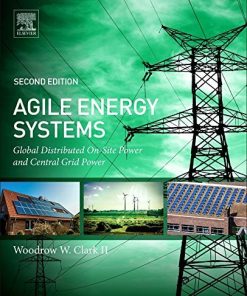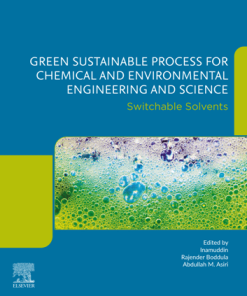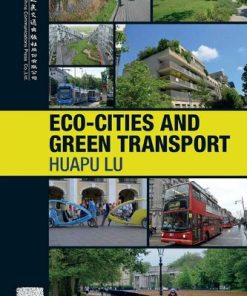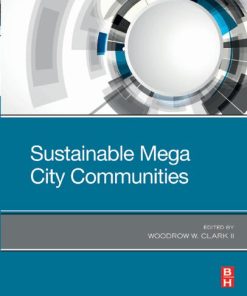(EBook PDF) Sustainable Cities and Communities Design Handbook Green Engineering Architecture and Technology 2nd Edition by Woodrow Clark 012813965X 9780128139653 full chapters
$50.00 Original price was: $50.00.$25.00Current price is: $25.00.
Sustainable Cities and Communities Design Handbook: Green Engineering, Architecture, and Technology 2nd Edition by Woodrow W. Clark – Ebook PDF Instant Download/DeliveryISBN: 012813965X, 9780128139653
Full dowload Sustainable Cities and Communities Design Handbook: Green Engineering, Architecture, and Technology 2nd Edition after payment.

Product details:
ISBN-10 : 012813965X
ISBN-13 : 9780128139653
Author: Woodrow W. Clark
Sustainable Communities Design Handbook: Green Engineering, Architecture, and Technology, Second Edition, brings together the major players responsible for sustainable development at both community and metropolitan scales. The book aims to explain and demonstrate the practice, planning, design, building and managing of the engineering, architectural and economic development of cities and communities to meet sustainable development objectives. Offering a holistic approach to creating sustainable communities, the book includes a 40 percent increase in new methods and technology over the last edition, and 50 percent more case studies from around the world to illustrate how common sustainability problems are solved.
Sustainable Cities and Communities Design Handbook: Green Engineering, Architecture, and Technology 2nd Table of contents:
Chapter 1. Introduction
Chapter 2. The Green Industrial Revolution
How Communities and Nations Move Ahead
What Is a Renewable Energy Power Source?
Deregulation Benefits: Myths About Economic Efficiency as Conservation Is Needed Too
The Issue of Deregulating Agile Energy Systems
Conclusion: Economic Development in an Agile Energy System
Appendix A: The Danish Case for the Green Industrial Revolution
Appendix B: E-mail Surveillance Data on ENRON
Appendix C: From Central Power Grid to Local Distributed Power Systems
Appendix D: Smart Grid That Includes Local Distributed Power and Renewable Energy Generation
Chapter 3. Cross-Disciplinary Scientific Foundation for Sustainability: Qualitative Economics
The Paradigm Shift: Economics as a Science
Subjectivism Paradigm: Lifeworld Perspective and Symbolic Interactionism
Philosophy of Science
Symbolic Interactionism: In the Subjectivist Theoretical Paradigm
Transformational Linguistics: Economic Rules of Formalism in Business Practices
Qualitative Economics: Toward a Science of Economics
Summary
Chapter 4. Political–Economic Governance of Renewable Energy Systems: The Key to Create Sustainable Communities
Corporate and Business Influences and Power
International Cases
China Leapfrogs Ahead
China Has “Leapfrogged” Into the Green Industrial Revolution
The Western Economic Paradigm Must Change
Introduction and Background
Conclusions and Future Research Recommendations
Chart A: The Germany Feed-in-Tariff Policy and Results (1990–2010)
Chart B: The Germany Feed-in-Tariff Policy Economic Results (1990–2007)
Chapter 5. Renewable Energy: Scaling Deployment in the United States and in Developing Economies
Introduction to Sources and Uses of Energy in the United States
Wind
Solar
Geothermal
Biopower
Marine and Hydrokinetic
Advanced Renewables Deployment
Summary of Scaling Renewables in the United States
The Energy Access Gap: Remote and Under-grid Populations Not Being Reached
Distributed Renewable Energy Solutions: Pivotal to Universal Energy Access
The Habits of Highly Effective Markets: Trends Across High-Performing Countries
From the Bottom Up: The Sierra Leone Success Story
Conclusions
Chapter 6. Development Partnership of Renewable Energies Technology and Smart Grid in China
Introduction
The Solar Electricity Systems and Their Relationship With the Grid
Wind Power
Data Response and Power Transmission Lines: Examples of the United States
The Smart Grid and Market Solution
China Rebuilds a Power System and Smart Grid
Chapter 7. Sustainable Towns: The Case of Frederikshavn Aiming at 100% Renewable Energy
Introduction
Definition of Renewable Energy
The Present Situation: Year 2007, Approximately 20% Renewable Energy
The First Step: Frederikshavn in the Year 2009
Frederikshavn in the Year of 2015
Energy System Analysis
Phase 3: Frederikshavn in the Year 2030—100% Renewable Energy and Less Biomass
Chapter 8. Life Cycle Analysis Versus Cost Benefit of Renewable Energy: Solar Systems Photovoltaics in Public Private Partnerships
Introduction
Life Cycle Analysis of a PV System From a Financial Perspective
Conclusion
Chapter 9. Public Buildings and Institutions: Solar Power and Energy Conservation as Solutions: Legal and Financial Mechanisms for Sustainable Buildings
Alternative Energy Public Policy
Legal Mechanisms Facilitating Development of Alternative Energy Sources
Treatment of Environmental Incentives
Chapter 10. Life Cycle Analysis: The Economic Analysis of Demand-Side Programs and Projects in California
The Basic Methodology
Participant Test
The Ratepayer Impact Measure Test (Refer to Point 5 of Notes)
Total Resource Cost Test (Refer to Point 6 of Notes)
Program Administrator Cost Test
Notes
Glossary of Symbols
Chapter 11. The Next Economics: Civic–Social Capitalism
Introduction
Economic Collaborations and Partnerships in Action
Conclusion: Maximizing the Public Good in Energy Economics
Chapter 12. Urban Circular Economy: The New Frontier for European Cities’ Sustainable Development
The Urban Circular Economy in Europe
The Big Cities Examples: Amsterdam, London, Paris, and Milan on the Leading Edge of the Urban Circular Economy
Where to Find the Resources to Invest in Urban Circular Economy?
The Role of Small Cities: the Italian Experience
References and Sources
Chart 1: Circular Economy and Its Impacts on Citizens’ Day-to-Day Life
Chart 2: The European Union Circular Economy Action Plan and the Role of the Cities
Chapter 13. Big Heart Intelligence in Healthy Workplaces and Sustainable Communities
How Far Have We Come?
Big Heart Intelligence Basics
Example 1: Big Heart Intelligence in the Design of Hospitals and Health Care Facilities
Example 2: Retirement Communities Linked to Universities and College Towns
Smart Technologies with a Heart
Evolving Buildings Within an Emerging New Paradigm in Global Health
Chapter 14. The European Union: Nordic Countries and Germany
Germany
Denmark
Sweden
Discussion
Chapter 15. Mauritius Island Nation: 100% Renewable Energy System by 2050
Introduction
Current Energy Status of Mauritius
The Government’s Vision of Renewable Energies up to 2025
Options for a 100% Renewable Energy System by 2050
Conclusions
Chapter 16. Urban Sustainability and Industrial Migration: The Green Transition of Hefei, China
Introduction
Green Urban Planning
Dueling Investments
Discussion and Conclusion
Chapter 17. Energy Economics in China’s Policy-Making Plan: From Self-Reliance and Market Dependence to Green Energy Independence
Introduction: From Self-Reliance to Dependency
The Real Predicament: Energy-Consumption-Based Economic Growth
The Rise of China in the Context of Energy Dependency
New Policy Thinking: Change of Economic Growth Strategy and Promoting Sustainable Energy
Conclusion Remarks: Challenges and Optimism Ahead
Chart 1
Chapter 18. Energy Strategy for Inner Mongolia Autonomous Region
Theme 1: Energy Base, Sustainable Development, and Finance
Theme 2: Differences That Exist Between Regions, Cities, and Nations
Theme 3: Long-Term Commitments
Recommendations and Conclusions
Implementing Measures
Conclusions
Supplemental Recommendations: Rural Inner Mongolia
Chapter 19. Business Ventures and Financial Sector in the United Arab Emirates
Introduction
Small and Medium Enterprises and the Government Financial Support
Ease of Doing Business in the UAE
Investment Bodies—The Key Players and Contributors
Legal Aspects of Conducting Business Activity
Banking Sector—The Structure and Recent Developments
Other Key Players of the Financial Market
Business Cooperation Between the UAE and Poland
The SWOT Analysis of the UAE Market—Business Perspective
Conclusions and Summary
Chapter 20. ECO-GEN Energy Solutions: Tahiti Story
Background
The Solution
The Tahiti Solution
Chapter 21. Japanese Smart Communities as Industrial Policy
Japanese Smart Communities: Plenty, but Poorly Promoted
Opening the Window on Japan’s Smart Communities
Higashi Matsushima City Smart Disaster Prevention Eco Town
The Power Business
Japan’s Incentives
Japan’s New Institutions
Smart Community Policy Entrepreneurs
Japan’s National Spatial Strategy
Policy Integration in the Compact City
Fiscal Support for Smart Communities
Post 3-11 Stakeholder Support for Smart Communities
Hirosaki Smart City
Conclusion
Chapter 22. Sustainable Communities in Costa Rica
Introduction
Sustainable Communities and Areas of Interest
The Future of Sustainable Communities in Costa Rica
Conclusion
Chapter 23. Sustainable Development Cases in Africa
Africa
Chapter 24. Sustainable Agriculture: The Food Chain
Introduction
Social Implications
Economic Implications
Environmental Implications
Developing New Solutions
Chapter 25. Insights on Establishing a Cohesive and Enduring Campus Sustainability Initiative
Insight 1: Many Campuses Still Need a Collective and Shared Definition of Sustainability, a Vision for Sustainability, and a Roadmap With Clear Goals and Metrics
Insight 2: Sustainability Is Being Established as an Institutional Priority Because It Is an Economic and Strategic Imperative for Organizational Growth, Competitiveness, and Long-Term Stakeholder Value Creation
Insight 3: The Opportunity Set for Financing Sustainability Projects Is Expanding and the Economic Returns Are Attractive
Insight 4: Collaboration Between Campuses and Communities Is Fundamental to Mitigate and Adapt to Climate Change at the Local and Regional Scale
Insight 5: Deep Engagement and Participation of Stakeholders is Vital for Embedding Sustainability Into the Culture of a School
Four Core Competencies to Consider for Ensuring a Successful Campus Sustainability Initiative
Chapter 26. The Power of Sustainability: The Story of Kent, Ohio
Background
Creation and Implementation of the Kent Sustainable Planning Approach
Steps in the Creation of the Bicentennial Plan
Implementing Multidimensional, Sustainable Goals
Central Gateway: Transforming Kent’s Downtown
Plan Implementation and Outcomes
Conclusion
Chapter 27. The Los Angeles Community College District: Establishing a Net Zero Energy Campus
Introduction
Background
Goal and Objectives
Importance of This Study
Current Situation
Solar PV Array and Setup
Conclusion
Appendix 1: Map of LA City College Campus Indicating Previous, Current, and Planned Renovations/Construction
Appendix 2: LADWP Energy Rates as of October 1, 2009—Specific for LACC Operations
Chapter 28. Case Study: University of California, Irvine
Chapter 29. “Scrappy” Sustainability at Ohio Wesleyan University
A Grassroots Model for Sustainability in Higher Education
The Context of Sustainability at Ohio Wesleyan University
Coordinating Sustainability Without a Sustainability Coordinator
“Scrappy Sustainability” Outcomes
A New Model for Sustainability?
Chapter 30. Afterword: A Sustainable Economic and Finance Proposal
The Problem
Economic Approaches: Overview in Brief
Conclusion Now and for Tomorrow
People also search for Sustainable Cities and Communities Design Handbook: Green Engineering, Architecture, and Technology 2nd:
sustainable cities and communities design handbook
sustainable cities and communities definition
sustainable cities and communities article
sustainable cities and communities ideas
sustainable cities and communities statistics
You may also like…
Calculus and Math
Business & Economics - Industries
Computers
Software Architecture and Design QuickStart Guide: An Engineering Approach Made Easy John Thomas
Engineering
Engineering - Environmental
Engineering - Environmental
Housekeeping & Leisure - Interior Design & Decoration
Sustainable Mega City Communities 1st Edition Woodrow W. Clark Ii



